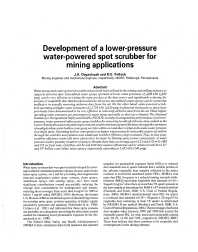Mining Publication: Development of a Lower-Pressure Water-Powered Spot Scrubber for Mining Applications
Original creation date: January 2006
Water sprays and water-powered scrubbers have both been used in the mining and milling industry to suppress airborne dust. Unconfined water sprays operating at lower water pressures (less than or equal to 100 psig) can be very effective at wetting the mine product at the dust source and significantly reducing the amount of respirable dust that becomes airborne. However, unconfined water sprays can be somewhat ineffective in actually removing airborne dust from the air. On the other hand, water-powered scrubbers operating at higher water pressures (greater than or equal to 250 psig) in physical enclosures or ducts have previously been shown to be very effective in removing airborne dust from the air. These higher operating water pressures are very uncommon to many mines and mills, so their use is limited. The National Institute for Occupational Safety and Health recently investigated the performance of a lower-pressure, water-powered in-line series spray scrubber for removing localized airborne dust emitted at the source. Results showed noticeable improvements in airborne dust capture efficiency through the operation of multiple in-line series hollow cone spray nozzles within a round duct of pipe at the same water pressure as a single spray. Operating hollow cone spray(s) at higher water pressures noticeably improved airflow through the scrubber and yielded some additional scrubber efficiency improvements. Thus, in-line spray scrubber efficiency tradeoffs were observed to be made by altering spray power components of water pressure and/or quantity (number of sprays). Results show that, on average, up to 484 and 679 cubic feet per minute of airflow at 0.69 and 0.81 dust capture efficiencies can be achieved with three 81- and 33-deg hollow cone in-line series sprays, respectively, operating at 240 psig.
Authors: JA Organiscak, DE Pollock
Peer Reviewed Journal Article - January 2006
NIOSHTIC2 Number: 20032624
Trans Soc Min Metall Explor 2006 Jan; 320:105-112
See Also
- Airborne Dust Capture and Induced Airflow of Various Spray Nozzle Designs
- Continuous Miner Spray Considerations for Optimizing Scrubber Performance in Exhaust Ventilation Systems
- Effect of Scrubber Operation on Airflow and Methane Patterns at the Mining Face
- The Effects of Water Spray Placement for Controlling Respirable Dust and Face Methane Concentrations
- Effects of Water Sprays and Scrubber Exhaust on Face Methane Concentrations
- Effects of Water Sprays Used With a Machine-Mounted Scrubber on Face Methane Concentrations
- Emerging Technologies Control Respirable Dust Exposures for Continuous Mining and Roof Bolting Personnel
- NIOSH Hazard ID 1 - Exposure to Silica Dust on Continuous Mining Operations Using Flooded-Bed Scrubbers
- Study of the Effects of Scrubber Operation on the Face Ventilation
- Using Water Sprays to Improve Performance of a Flooded-Bed Dust Scrubber
- Content source: National Institute for Occupational Safety and Health, Mining Program


 ShareCompartir
ShareCompartir
